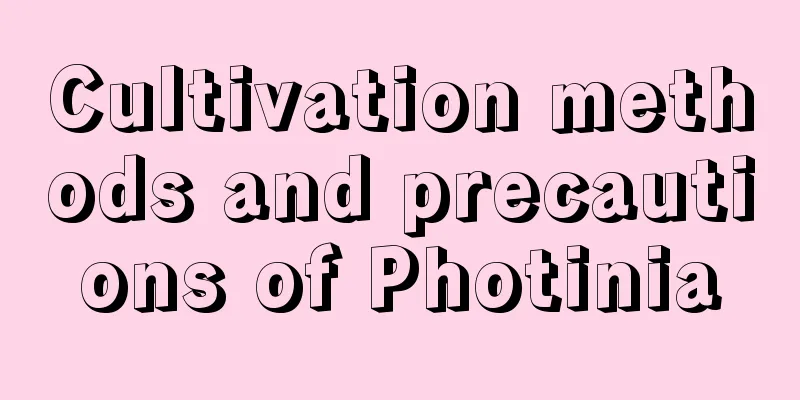Planting technology and cultivation methods of Belamcanda chinensis

|
Belamcanda chinensis is a plant with extremely strong adaptability and is not very demanding on its growing environment. Belamcanda chinensis prefers an environment with plenty of sunlight and can adapt to warm and humid climatic conditions. Not only is it drought tolerant, it is also very cold tolerant and can overwinter safely in areas where temperatures drop to -17°C, although it may need covering with soil or mulch to protect its roots during the cold season. Let’s learn about the planting techniques and cultivation methods of Belamcanda chinensis. 1. Land selection and preparation The land for planting Belamcanda chinensis can be hillside wasteland or flat land, but the most suitable land is neutral or slightly acidic soil with sufficient sunlight, fertile soil, good drainage and high terrain. Planting in low-lying areas prone to waterlogging should be avoided. Apply 3,000 kg of farmyard manure and 30 kg of superphosphate to every 1,000 square meters of land, plow and harrow it to make ridges 20 cm high and 1.3 meters wide. You can also choose to use special fertilizers for Chinese medicinal materials . 2. Breeding method Propagation by division: Select seedlings that are more than 2 years old and carry out the division after the leaves fall in autumn or before the seedlings emerge in spring. Dig out the old rhizomes, select healthy rhizomes, cut them into 3-4 cm long root segments, and retain 2-3 root buds in each segment. On the prepared bed surface, dig holes at a spacing of 30 cm x 30 cm, place 1-2 sections of rhizomes in each hole, make sure the buds are facing upwards, cover with soil, compact it, and water it. If there are green shoots, make sure the heads are above ground. Seed propagation: Harvest the seeds in September and October when the capsule turns yellow and is about to crack, and sow them after drying. It can be broadcast or drilled, with row spacing controlled at 15-20 cm and covered with 2-3 cm of soil after sowing. It takes about 20-30 days for seedlings to emerge. If sowing is too late, they will not emerge that year, but will only emerge in March of the following year. Use 6 kg of seeds per 1000 square meters of nursery area. In April and May, when the seedlings are 6-10 cm tall, they can be transplanted to the field. When transplanting, dig holes on the prepared bed with a plant spacing of 30 cm × 30 cm. The hole depth is 5-6 cm. Plant 1-2 plants in each hole. Fill the soil and compact it, then water it. Spring sowing is carried out in March and April, using the same method as autumn, but it should be noted that the seeds harvested in autumn should be stored in wet sand to maintain their germination ability. 3. Field management Intertillage and weeding: Weed and loosen the soil in time after seedlings emerge. Stop intertillage after the plants are covered with ridges in June and July, and add soil appropriately to prevent lodging. Top dressing: It is usually carried out before freezing or in early spring, mainly with human feces or wood ash. It is not advisable to apply fertilizer in summer and flowering period. After the seedlings propagated by transplanting and division survive, you can apply diluted manure water 1-2 times, or spread urea in time after rain, 20 kg per 1,000 square meters. Irrigation and drainage: Water promptly after planting to facilitate survival, and then water in time according to the drought conditions. When there is too much rain, drain the accumulated water in time to prevent root rot. Picking buds: In addition to leaving them in the seed field, remove flower buds on sunny days to promote the growth of underground rhizomes. 4. Pest and disease control Rust disease: Leaves are easily affected in autumn. In the early stage of the disease, spray 2000 times diluted 25% oxycarboxin for prevention and control. Belamcanda chinensis borer: In early May, the larvae damage leaf sheaths, young heart leaves and stem bases. Spray with 2000 times diluted 50% phosphorus emulsion, or 800 times diluted 90% trichlorfon. Also pay attention to underground pests such as white grubs and mole crickets. 5. Harvesting and processing The Belamcanda chinensis can be harvested 2-3 years after planting. When the aboveground part withers in autumn and before it sprouts in the following spring, choose a sunny day to dig up the rhizomes. Wash the dirt off the dug rhizomes, cut off the fibrous roots, and dry them in the sun or in an oven. The above is an introduction to the key points of Belamcanda chinensis cultivation techniques. As a Chinese medicinal plant with a large market demand, Belamcanda chinensis has good prospects for cultivation. If you want to obtain the maximum yield of Belamcanda chinensis, then learning the cultivation techniques well is very important.
|
<<: How to propagate water spinach by cuttings?
>>: Key points and advantages and disadvantages of corn wide and narrow row planting technology
Recommend
How to make pine nuts sprout quickly
Pine nut germination environment The thin slices ...
How to care for cut spring silk
1. Fertilization The stems of the cut spring sedg...
Cultivation methods and precautions of Jin Sulan
How to cultivate Jin Sulan soil Chimonanthus pref...
Is Calla Lily poisonous?
1. Is it toxic? Calla lily is poisonous. The whol...
The reason why hydroponic taro smells bad
1. Reasons for the stinky smell 1. Not changing t...
How to grow lantern flowers at home
Lantern flower growing conditions The suitable gr...
How to preserve sweet potato vines for planting the following year (can they be stored in winter and planted next year)
Traditional sweet potato seedling cultivation is ...
What kind of green orchid is this?
1. What is the species? There are many varieties ...
How to water hibiscus
Watering tips for hibiscus Hibiscus is also known...
How to repot Podocarpus
Podocarpus repotting time When growing Podocarpus...
Can orchids be watered with sugar water?
1. Can I pour sugar water? You can use sugar wate...
What vegetables are best to grow in February?
In February, vegetables suitable for sowing inclu...
Hydroponics video: Do you still use soil to grow flowers? Hydroponics is fine!
Hydroponics Video Changing from soil culture to h...
Potato planting method steps and pictures Potato planting time and method
Potatoes should be planted reasonably, early-matu...
How long is the growth cycle of eucalyptus?
Eucalyptus Growth Introduction Eucalyptus trees a...









